Strategic Analysis of Vodafone: Macro Environment, Strategy, and Plan
VerifiedAdded on 2020/12/09
|13
|4360
|357
Report
AI Summary
This report provides a comprehensive analysis of Vodafone's business strategy, examining its macro and internal environments. It begins with an introduction to business strategy and its importance, followed by a detailed analysis of the macro environment using PESTLE analysis, considering political, economic, social, technological, legal, and environmental factors. The report then explores the application of Ansoff's growth vector matrix to Vodafone's strategic decisions. Furthermore, the report assesses Vodafone's internal environment, focusing on strategic capabilities and utilizing VRIO analysis to evaluate its resources and competitive advantages. The analysis covers valuable, rare, and costly-to-imitate resources. The report also explores strategic management plan with tactical and tangible strategic objectives for Vodafone. The report concludes with a summary of findings and recommendations, highlighting key strategies for Vodafone's success in the telecommunications sector. The report aims to provide a thorough understanding of Vodafone's strategic position and offers insights into its future growth prospects.
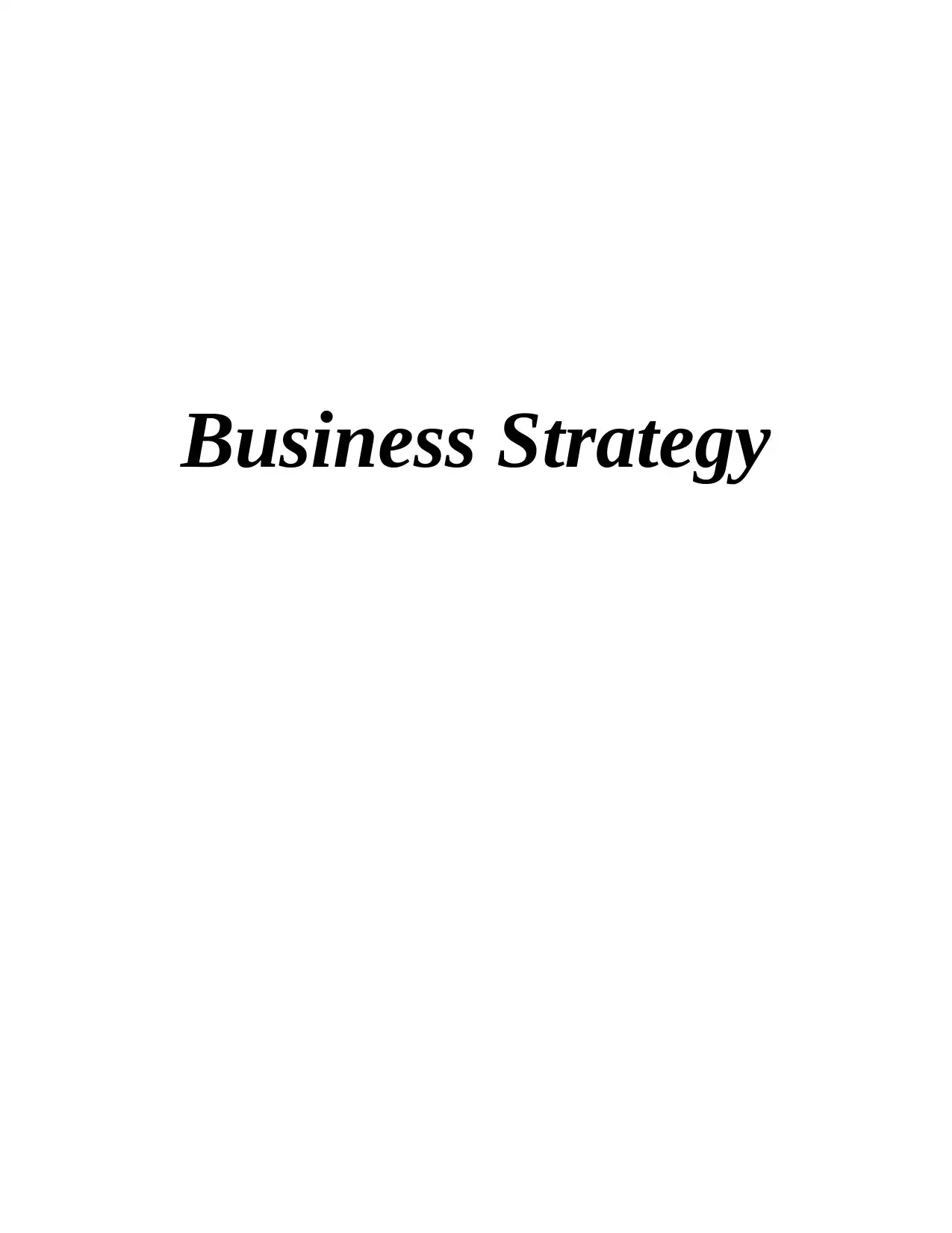
Business Strategy
Paraphrase This Document
Need a fresh take? Get an instant paraphrase of this document with our AI Paraphraser
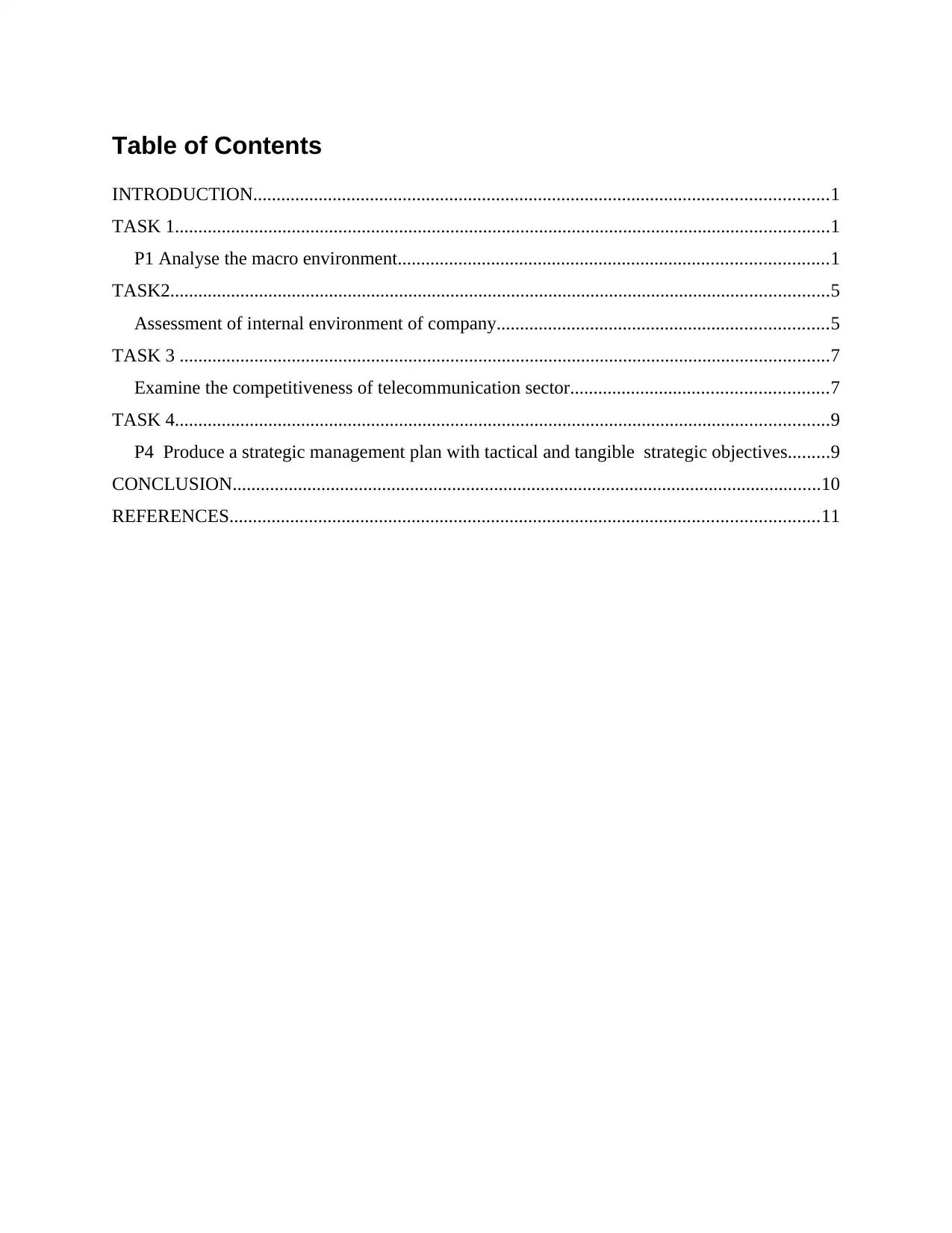
Table of Contents
INTRODUCTION...........................................................................................................................1
TASK 1............................................................................................................................................1
P1 Analyse the macro environment............................................................................................1
TASK2.............................................................................................................................................5
Assessment of internal environment of company.......................................................................5
TASK 3 ...........................................................................................................................................7
Examine the competitiveness of telecommunication sector.......................................................7
TASK 4............................................................................................................................................9
P4 Produce a strategic management plan with tactical and tangible strategic objectives.........9
CONCLUSION..............................................................................................................................10
REFERENCES..............................................................................................................................11
INTRODUCTION...........................................................................................................................1
TASK 1............................................................................................................................................1
P1 Analyse the macro environment............................................................................................1
TASK2.............................................................................................................................................5
Assessment of internal environment of company.......................................................................5
TASK 3 ...........................................................................................................................................7
Examine the competitiveness of telecommunication sector.......................................................7
TASK 4............................................................................................................................................9
P4 Produce a strategic management plan with tactical and tangible strategic objectives.........9
CONCLUSION..............................................................................................................................10
REFERENCES..............................................................................................................................11
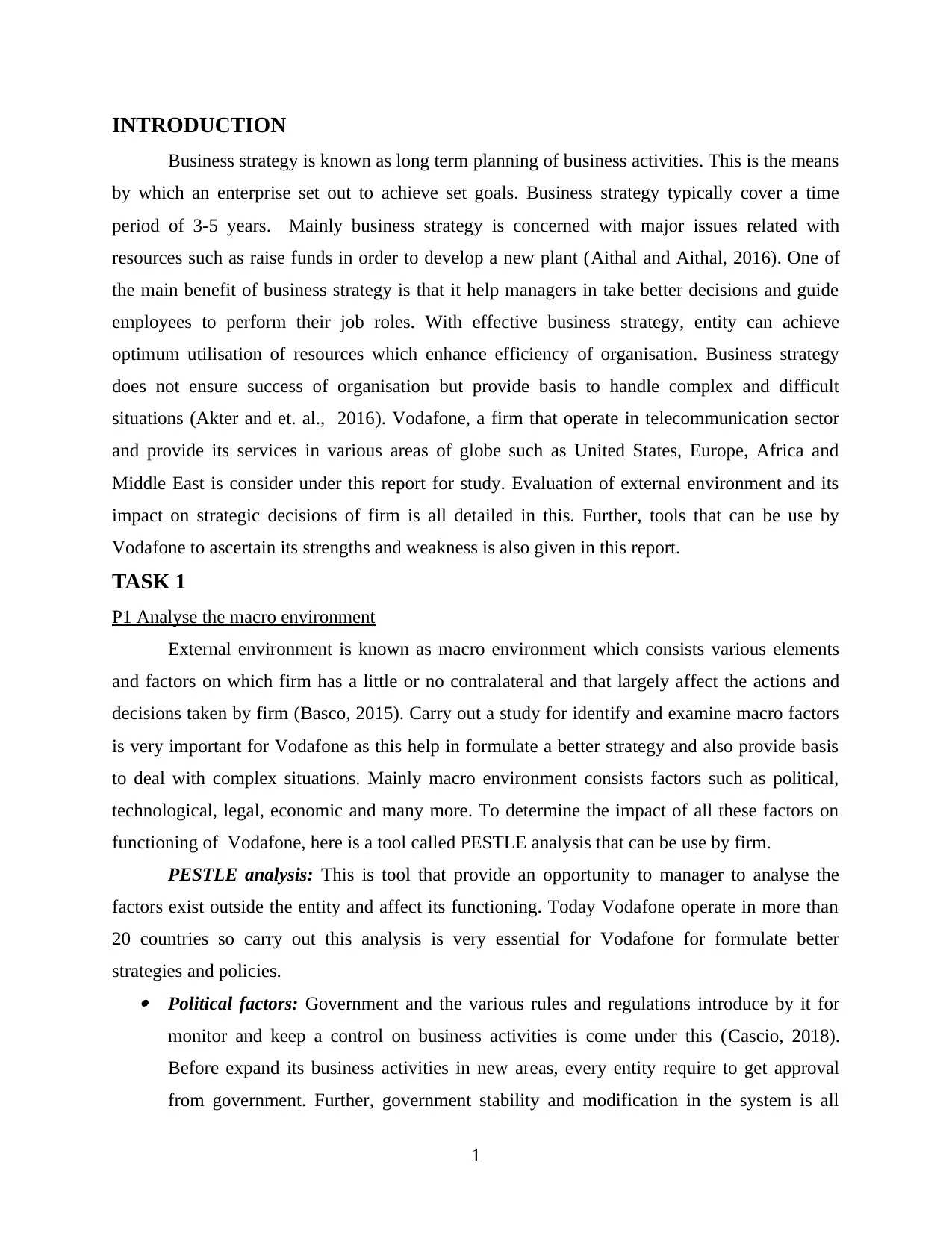
INTRODUCTION
Business strategy is known as long term planning of business activities. This is the means
by which an enterprise set out to achieve set goals. Business strategy typically cover a time
period of 3-5 years. Mainly business strategy is concerned with major issues related with
resources such as raise funds in order to develop a new plant (Aithal and Aithal, 2016). One of
the main benefit of business strategy is that it help managers in take better decisions and guide
employees to perform their job roles. With effective business strategy, entity can achieve
optimum utilisation of resources which enhance efficiency of organisation. Business strategy
does not ensure success of organisation but provide basis to handle complex and difficult
situations (Akter and et. al., 2016). Vodafone, a firm that operate in telecommunication sector
and provide its services in various areas of globe such as United States, Europe, Africa and
Middle East is consider under this report for study. Evaluation of external environment and its
impact on strategic decisions of firm is all detailed in this. Further, tools that can be use by
Vodafone to ascertain its strengths and weakness is also given in this report.
TASK 1
P1 Analyse the macro environment
External environment is known as macro environment which consists various elements
and factors on which firm has a little or no contralateral and that largely affect the actions and
decisions taken by firm (Basco, 2015). Carry out a study for identify and examine macro factors
is very important for Vodafone as this help in formulate a better strategy and also provide basis
to deal with complex situations. Mainly macro environment consists factors such as political,
technological, legal, economic and many more. To determine the impact of all these factors on
functioning of Vodafone, here is a tool called PESTLE analysis that can be use by firm.
PESTLE analysis: This is tool that provide an opportunity to manager to analyse the
factors exist outside the entity and affect its functioning. Today Vodafone operate in more than
20 countries so carry out this analysis is very essential for Vodafone for formulate better
strategies and policies. Political factors: Government and the various rules and regulations introduce by it for
monitor and keep a control on business activities is come under this (Cascio, 2018).
Before expand its business activities in new areas, every entity require to get approval
from government. Further, government stability and modification in the system is all
1
Business strategy is known as long term planning of business activities. This is the means
by which an enterprise set out to achieve set goals. Business strategy typically cover a time
period of 3-5 years. Mainly business strategy is concerned with major issues related with
resources such as raise funds in order to develop a new plant (Aithal and Aithal, 2016). One of
the main benefit of business strategy is that it help managers in take better decisions and guide
employees to perform their job roles. With effective business strategy, entity can achieve
optimum utilisation of resources which enhance efficiency of organisation. Business strategy
does not ensure success of organisation but provide basis to handle complex and difficult
situations (Akter and et. al., 2016). Vodafone, a firm that operate in telecommunication sector
and provide its services in various areas of globe such as United States, Europe, Africa and
Middle East is consider under this report for study. Evaluation of external environment and its
impact on strategic decisions of firm is all detailed in this. Further, tools that can be use by
Vodafone to ascertain its strengths and weakness is also given in this report.
TASK 1
P1 Analyse the macro environment
External environment is known as macro environment which consists various elements
and factors on which firm has a little or no contralateral and that largely affect the actions and
decisions taken by firm (Basco, 2015). Carry out a study for identify and examine macro factors
is very important for Vodafone as this help in formulate a better strategy and also provide basis
to deal with complex situations. Mainly macro environment consists factors such as political,
technological, legal, economic and many more. To determine the impact of all these factors on
functioning of Vodafone, here is a tool called PESTLE analysis that can be use by firm.
PESTLE analysis: This is tool that provide an opportunity to manager to analyse the
factors exist outside the entity and affect its functioning. Today Vodafone operate in more than
20 countries so carry out this analysis is very essential for Vodafone for formulate better
strategies and policies. Political factors: Government and the various rules and regulations introduce by it for
monitor and keep a control on business activities is come under this (Cascio, 2018).
Before expand its business activities in new areas, every entity require to get approval
from government. Further, government stability and modification in the system is all
1
⊘ This is a preview!⊘
Do you want full access?
Subscribe today to unlock all pages.

Trusted by 1+ million students worldwide
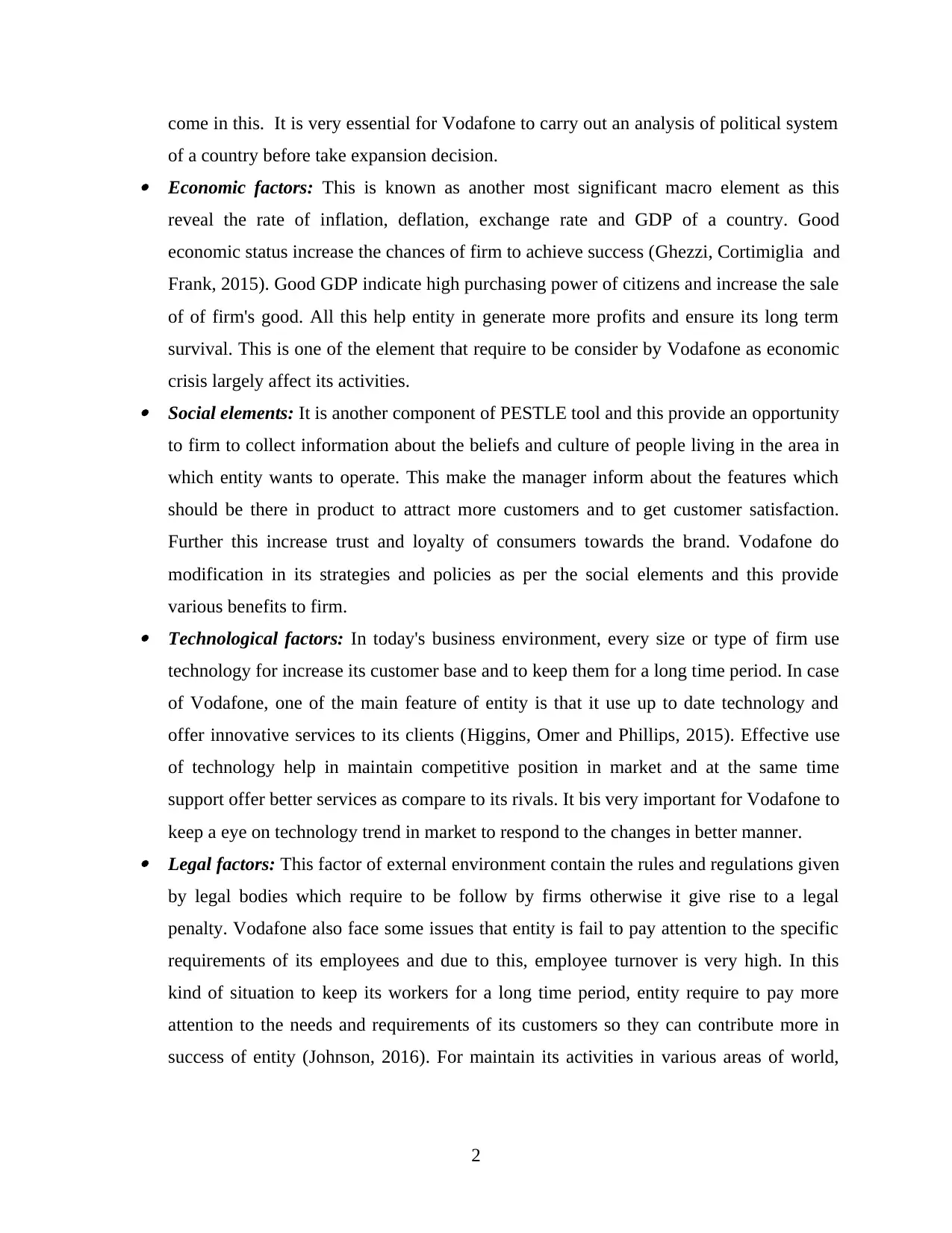
come in this. It is very essential for Vodafone to carry out an analysis of political system
of a country before take expansion decision. Economic factors: This is known as another most significant macro element as this
reveal the rate of inflation, deflation, exchange rate and GDP of a country. Good
economic status increase the chances of firm to achieve success (Ghezzi, Cortimiglia and
Frank, 2015). Good GDP indicate high purchasing power of citizens and increase the sale
of of firm's good. All this help entity in generate more profits and ensure its long term
survival. This is one of the element that require to be consider by Vodafone as economic
crisis largely affect its activities. Social elements: It is another component of PESTLE tool and this provide an opportunity
to firm to collect information about the beliefs and culture of people living in the area in
which entity wants to operate. This make the manager inform about the features which
should be there in product to attract more customers and to get customer satisfaction.
Further this increase trust and loyalty of consumers towards the brand. Vodafone do
modification in its strategies and policies as per the social elements and this provide
various benefits to firm. Technological factors: In today's business environment, every size or type of firm use
technology for increase its customer base and to keep them for a long time period. In case
of Vodafone, one of the main feature of entity is that it use up to date technology and
offer innovative services to its clients (Higgins, Omer and Phillips, 2015). Effective use
of technology help in maintain competitive position in market and at the same time
support offer better services as compare to its rivals. It bis very important for Vodafone to
keep a eye on technology trend in market to respond to the changes in better manner. Legal factors: This factor of external environment contain the rules and regulations given
by legal bodies which require to be follow by firms otherwise it give rise to a legal
penalty. Vodafone also face some issues that entity is fail to pay attention to the specific
requirements of its employees and due to this, employee turnover is very high. In this
kind of situation to keep its workers for a long time period, entity require to pay more
attention to the needs and requirements of its customers so they can contribute more in
success of entity (Johnson, 2016). For maintain its activities in various areas of world,
2
of a country before take expansion decision. Economic factors: This is known as another most significant macro element as this
reveal the rate of inflation, deflation, exchange rate and GDP of a country. Good
economic status increase the chances of firm to achieve success (Ghezzi, Cortimiglia and
Frank, 2015). Good GDP indicate high purchasing power of citizens and increase the sale
of of firm's good. All this help entity in generate more profits and ensure its long term
survival. This is one of the element that require to be consider by Vodafone as economic
crisis largely affect its activities. Social elements: It is another component of PESTLE tool and this provide an opportunity
to firm to collect information about the beliefs and culture of people living in the area in
which entity wants to operate. This make the manager inform about the features which
should be there in product to attract more customers and to get customer satisfaction.
Further this increase trust and loyalty of consumers towards the brand. Vodafone do
modification in its strategies and policies as per the social elements and this provide
various benefits to firm. Technological factors: In today's business environment, every size or type of firm use
technology for increase its customer base and to keep them for a long time period. In case
of Vodafone, one of the main feature of entity is that it use up to date technology and
offer innovative services to its clients (Higgins, Omer and Phillips, 2015). Effective use
of technology help in maintain competitive position in market and at the same time
support offer better services as compare to its rivals. It bis very important for Vodafone to
keep a eye on technology trend in market to respond to the changes in better manner. Legal factors: This factor of external environment contain the rules and regulations given
by legal bodies which require to be follow by firms otherwise it give rise to a legal
penalty. Vodafone also face some issues that entity is fail to pay attention to the specific
requirements of its employees and due to this, employee turnover is very high. In this
kind of situation to keep its workers for a long time period, entity require to pay more
attention to the needs and requirements of its customers so they can contribute more in
success of entity (Johnson, 2016). For maintain its activities in various areas of world,
2
Paraphrase This Document
Need a fresh take? Get an instant paraphrase of this document with our AI Paraphraser
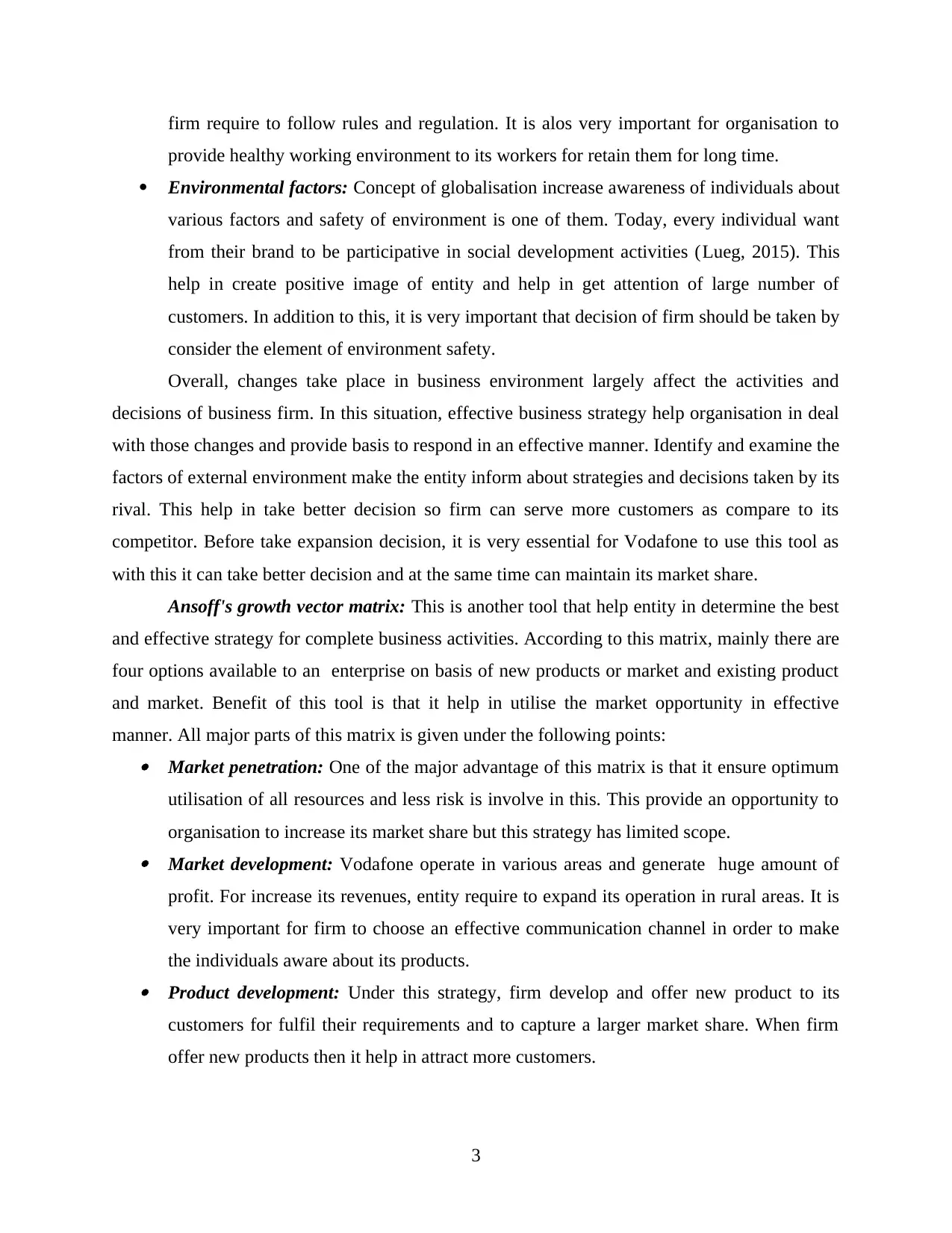
firm require to follow rules and regulation. It is alos very important for organisation to
provide healthy working environment to its workers for retain them for long time.
Environmental factors: Concept of globalisation increase awareness of individuals about
various factors and safety of environment is one of them. Today, every individual want
from their brand to be participative in social development activities (Lueg, 2015). This
help in create positive image of entity and help in get attention of large number of
customers. In addition to this, it is very important that decision of firm should be taken by
consider the element of environment safety.
Overall, changes take place in business environment largely affect the activities and
decisions of business firm. In this situation, effective business strategy help organisation in deal
with those changes and provide basis to respond in an effective manner. Identify and examine the
factors of external environment make the entity inform about strategies and decisions taken by its
rival. This help in take better decision so firm can serve more customers as compare to its
competitor. Before take expansion decision, it is very essential for Vodafone to use this tool as
with this it can take better decision and at the same time can maintain its market share.
Ansoff's growth vector matrix: This is another tool that help entity in determine the best
and effective strategy for complete business activities. According to this matrix, mainly there are
four options available to an enterprise on basis of new products or market and existing product
and market. Benefit of this tool is that it help in utilise the market opportunity in effective
manner. All major parts of this matrix is given under the following points: Market penetration: One of the major advantage of this matrix is that it ensure optimum
utilisation of all resources and less risk is involve in this. This provide an opportunity to
organisation to increase its market share but this strategy has limited scope. Market development: Vodafone operate in various areas and generate huge amount of
profit. For increase its revenues, entity require to expand its operation in rural areas. It is
very important for firm to choose an effective communication channel in order to make
the individuals aware about its products. Product development: Under this strategy, firm develop and offer new product to its
customers for fulfil their requirements and to capture a larger market share. When firm
offer new products then it help in attract more customers.
3
provide healthy working environment to its workers for retain them for long time.
Environmental factors: Concept of globalisation increase awareness of individuals about
various factors and safety of environment is one of them. Today, every individual want
from their brand to be participative in social development activities (Lueg, 2015). This
help in create positive image of entity and help in get attention of large number of
customers. In addition to this, it is very important that decision of firm should be taken by
consider the element of environment safety.
Overall, changes take place in business environment largely affect the activities and
decisions of business firm. In this situation, effective business strategy help organisation in deal
with those changes and provide basis to respond in an effective manner. Identify and examine the
factors of external environment make the entity inform about strategies and decisions taken by its
rival. This help in take better decision so firm can serve more customers as compare to its
competitor. Before take expansion decision, it is very essential for Vodafone to use this tool as
with this it can take better decision and at the same time can maintain its market share.
Ansoff's growth vector matrix: This is another tool that help entity in determine the best
and effective strategy for complete business activities. According to this matrix, mainly there are
four options available to an enterprise on basis of new products or market and existing product
and market. Benefit of this tool is that it help in utilise the market opportunity in effective
manner. All major parts of this matrix is given under the following points: Market penetration: One of the major advantage of this matrix is that it ensure optimum
utilisation of all resources and less risk is involve in this. This provide an opportunity to
organisation to increase its market share but this strategy has limited scope. Market development: Vodafone operate in various areas and generate huge amount of
profit. For increase its revenues, entity require to expand its operation in rural areas. It is
very important for firm to choose an effective communication channel in order to make
the individuals aware about its products. Product development: Under this strategy, firm develop and offer new product to its
customers for fulfil their requirements and to capture a larger market share. When firm
offer new products then it help in attract more customers.
3
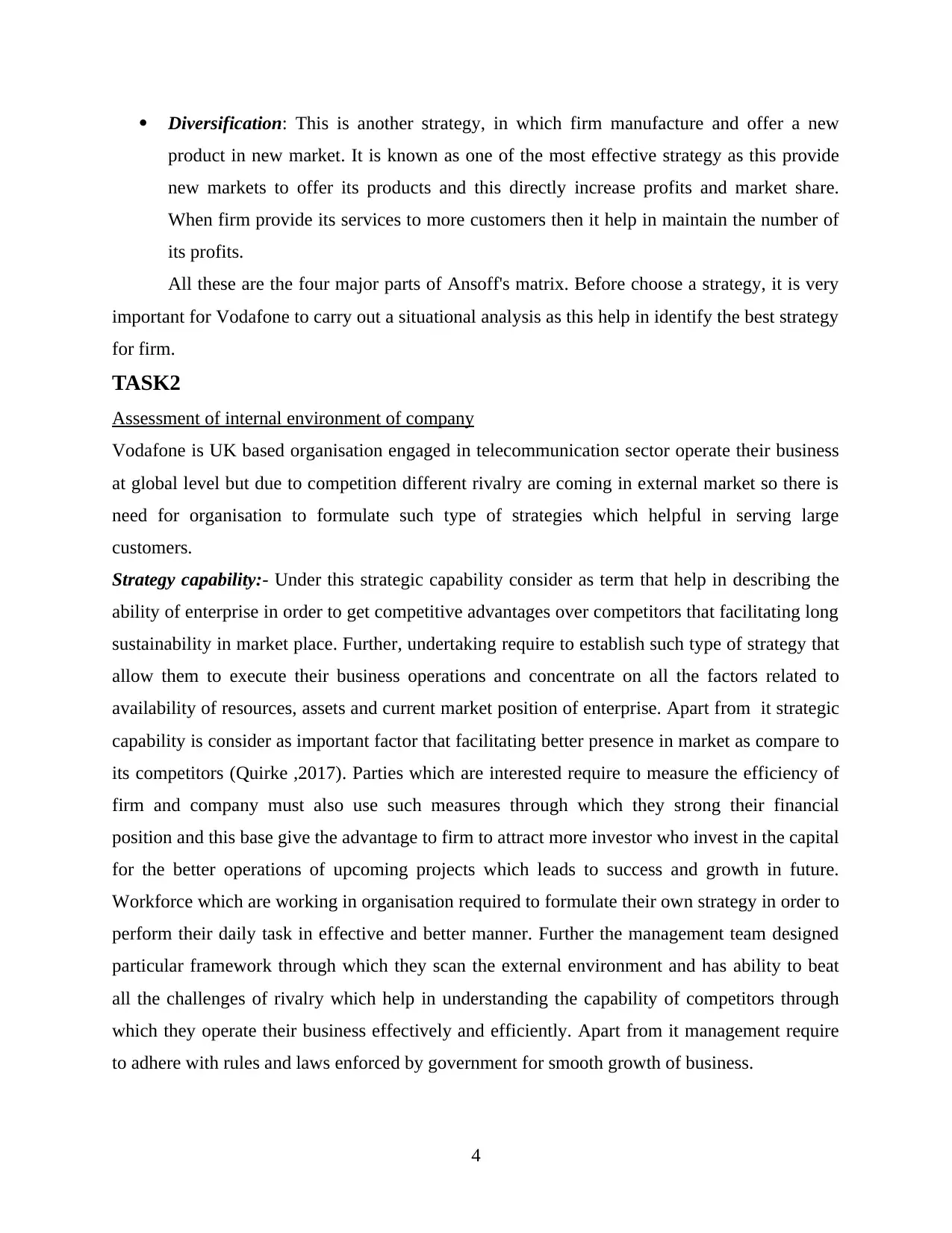
Diversification: This is another strategy, in which firm manufacture and offer a new
product in new market. It is known as one of the most effective strategy as this provide
new markets to offer its products and this directly increase profits and market share.
When firm provide its services to more customers then it help in maintain the number of
its profits.
All these are the four major parts of Ansoff's matrix. Before choose a strategy, it is very
important for Vodafone to carry out a situational analysis as this help in identify the best strategy
for firm.
TASK2
Assessment of internal environment of company
Vodafone is UK based organisation engaged in telecommunication sector operate their business
at global level but due to competition different rivalry are coming in external market so there is
need for organisation to formulate such type of strategies which helpful in serving large
customers.
Strategy capability:- Under this strategic capability consider as term that help in describing the
ability of enterprise in order to get competitive advantages over competitors that facilitating long
sustainability in market place. Further, undertaking require to establish such type of strategy that
allow them to execute their business operations and concentrate on all the factors related to
availability of resources, assets and current market position of enterprise. Apart from it strategic
capability is consider as important factor that facilitating better presence in market as compare to
its competitors (Quirke ,2017). Parties which are interested require to measure the efficiency of
firm and company must also use such measures through which they strong their financial
position and this base give the advantage to firm to attract more investor who invest in the capital
for the better operations of upcoming projects which leads to success and growth in future.
Workforce which are working in organisation required to formulate their own strategy in order to
perform their daily task in effective and better manner. Further the management team designed
particular framework through which they scan the external environment and has ability to beat
all the challenges of rivalry which help in understanding the capability of competitors through
which they operate their business effectively and efficiently. Apart from it management require
to adhere with rules and laws enforced by government for smooth growth of business.
4
product in new market. It is known as one of the most effective strategy as this provide
new markets to offer its products and this directly increase profits and market share.
When firm provide its services to more customers then it help in maintain the number of
its profits.
All these are the four major parts of Ansoff's matrix. Before choose a strategy, it is very
important for Vodafone to carry out a situational analysis as this help in identify the best strategy
for firm.
TASK2
Assessment of internal environment of company
Vodafone is UK based organisation engaged in telecommunication sector operate their business
at global level but due to competition different rivalry are coming in external market so there is
need for organisation to formulate such type of strategies which helpful in serving large
customers.
Strategy capability:- Under this strategic capability consider as term that help in describing the
ability of enterprise in order to get competitive advantages over competitors that facilitating long
sustainability in market place. Further, undertaking require to establish such type of strategy that
allow them to execute their business operations and concentrate on all the factors related to
availability of resources, assets and current market position of enterprise. Apart from it strategic
capability is consider as important factor that facilitating better presence in market as compare to
its competitors (Quirke ,2017). Parties which are interested require to measure the efficiency of
firm and company must also use such measures through which they strong their financial
position and this base give the advantage to firm to attract more investor who invest in the capital
for the better operations of upcoming projects which leads to success and growth in future.
Workforce which are working in organisation required to formulate their own strategy in order to
perform their daily task in effective and better manner. Further the management team designed
particular framework through which they scan the external environment and has ability to beat
all the challenges of rivalry which help in understanding the capability of competitors through
which they operate their business effectively and efficiently. Apart from it management require
to adhere with rules and laws enforced by government for smooth growth of business.
4
⊘ This is a preview!⊘
Do you want full access?
Subscribe today to unlock all pages.

Trusted by 1+ million students worldwide
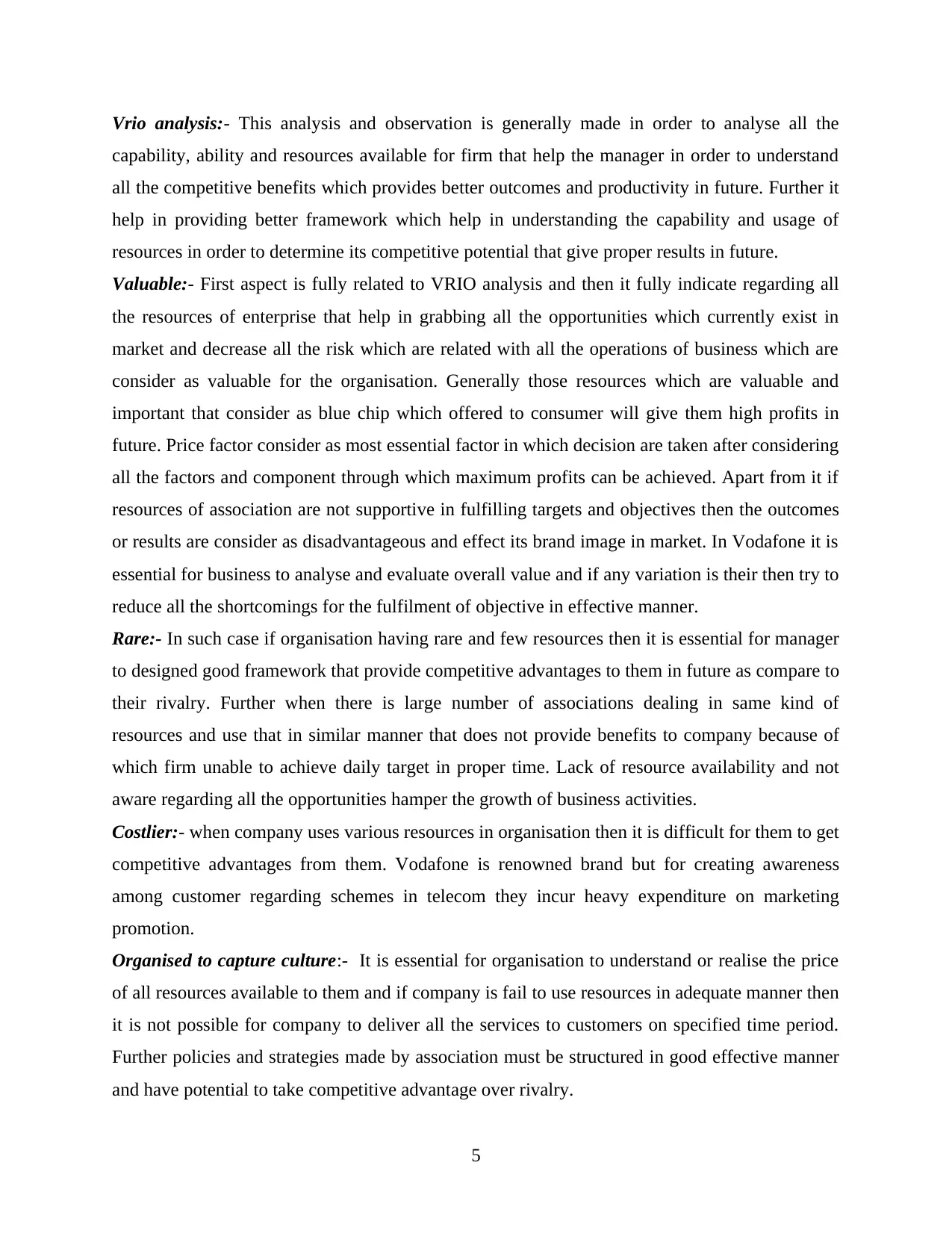
Vrio analysis:- This analysis and observation is generally made in order to analyse all the
capability, ability and resources available for firm that help the manager in order to understand
all the competitive benefits which provides better outcomes and productivity in future. Further it
help in providing better framework which help in understanding the capability and usage of
resources in order to determine its competitive potential that give proper results in future.
Valuable:- First aspect is fully related to VRIO analysis and then it fully indicate regarding all
the resources of enterprise that help in grabbing all the opportunities which currently exist in
market and decrease all the risk which are related with all the operations of business which are
consider as valuable for the organisation. Generally those resources which are valuable and
important that consider as blue chip which offered to consumer will give them high profits in
future. Price factor consider as most essential factor in which decision are taken after considering
all the factors and component through which maximum profits can be achieved. Apart from it if
resources of association are not supportive in fulfilling targets and objectives then the outcomes
or results are consider as disadvantageous and effect its brand image in market. In Vodafone it is
essential for business to analyse and evaluate overall value and if any variation is their then try to
reduce all the shortcomings for the fulfilment of objective in effective manner.
Rare:- In such case if organisation having rare and few resources then it is essential for manager
to designed good framework that provide competitive advantages to them in future as compare to
their rivalry. Further when there is large number of associations dealing in same kind of
resources and use that in similar manner that does not provide benefits to company because of
which firm unable to achieve daily target in proper time. Lack of resource availability and not
aware regarding all the opportunities hamper the growth of business activities.
Costlier:- when company uses various resources in organisation then it is difficult for them to get
competitive advantages from them. Vodafone is renowned brand but for creating awareness
among customer regarding schemes in telecom they incur heavy expenditure on marketing
promotion.
Organised to capture culture:- It is essential for organisation to understand or realise the price
of all resources available to them and if company is fail to use resources in adequate manner then
it is not possible for company to deliver all the services to customers on specified time period.
Further policies and strategies made by association must be structured in good effective manner
and have potential to take competitive advantage over rivalry.
5
capability, ability and resources available for firm that help the manager in order to understand
all the competitive benefits which provides better outcomes and productivity in future. Further it
help in providing better framework which help in understanding the capability and usage of
resources in order to determine its competitive potential that give proper results in future.
Valuable:- First aspect is fully related to VRIO analysis and then it fully indicate regarding all
the resources of enterprise that help in grabbing all the opportunities which currently exist in
market and decrease all the risk which are related with all the operations of business which are
consider as valuable for the organisation. Generally those resources which are valuable and
important that consider as blue chip which offered to consumer will give them high profits in
future. Price factor consider as most essential factor in which decision are taken after considering
all the factors and component through which maximum profits can be achieved. Apart from it if
resources of association are not supportive in fulfilling targets and objectives then the outcomes
or results are consider as disadvantageous and effect its brand image in market. In Vodafone it is
essential for business to analyse and evaluate overall value and if any variation is their then try to
reduce all the shortcomings for the fulfilment of objective in effective manner.
Rare:- In such case if organisation having rare and few resources then it is essential for manager
to designed good framework that provide competitive advantages to them in future as compare to
their rivalry. Further when there is large number of associations dealing in same kind of
resources and use that in similar manner that does not provide benefits to company because of
which firm unable to achieve daily target in proper time. Lack of resource availability and not
aware regarding all the opportunities hamper the growth of business activities.
Costlier:- when company uses various resources in organisation then it is difficult for them to get
competitive advantages from them. Vodafone is renowned brand but for creating awareness
among customer regarding schemes in telecom they incur heavy expenditure on marketing
promotion.
Organised to capture culture:- It is essential for organisation to understand or realise the price
of all resources available to them and if company is fail to use resources in adequate manner then
it is not possible for company to deliver all the services to customers on specified time period.
Further policies and strategies made by association must be structured in good effective manner
and have potential to take competitive advantage over rivalry.
5
Paraphrase This Document
Need a fresh take? Get an instant paraphrase of this document with our AI Paraphraser
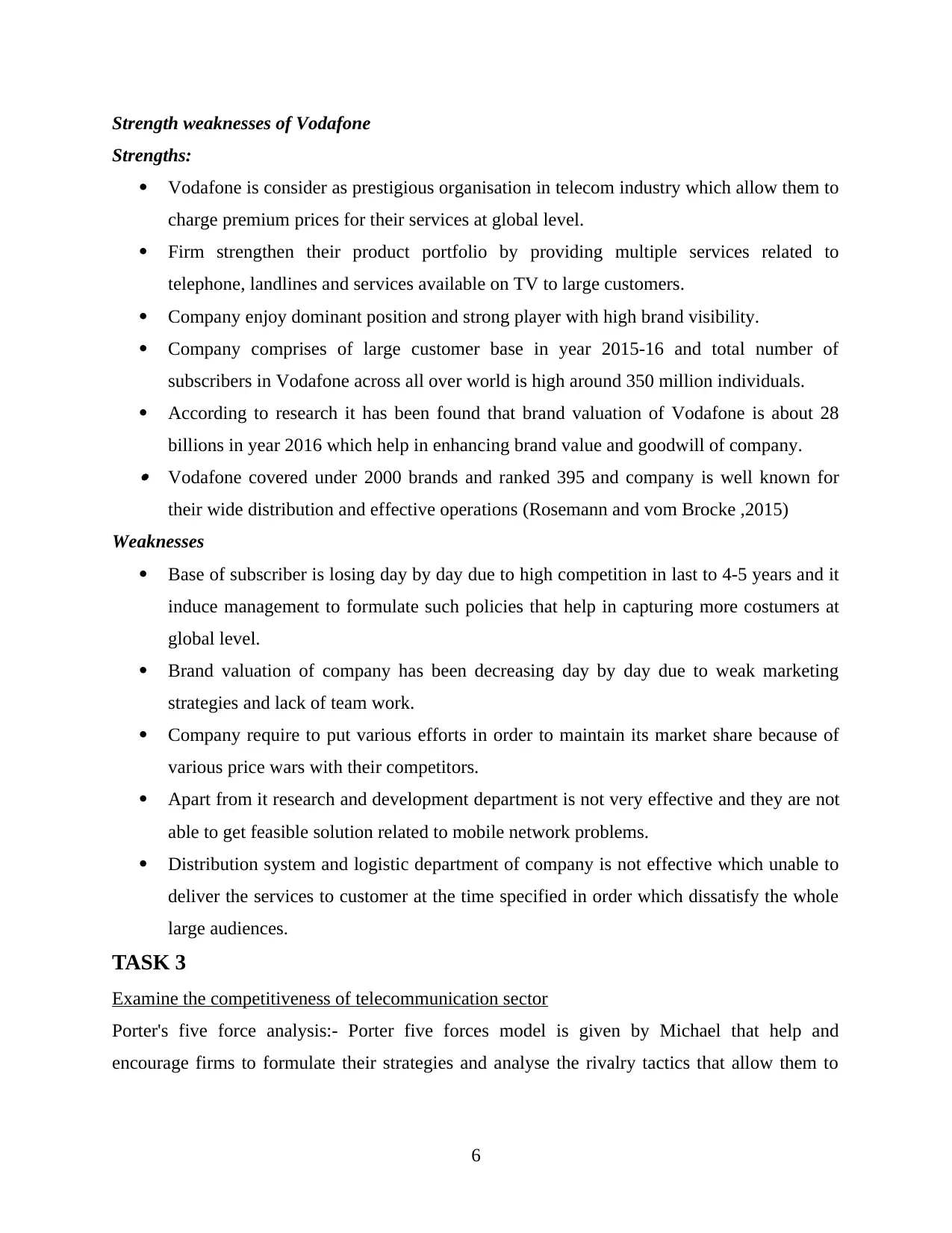
Strength weaknesses of Vodafone
Strengths:
Vodafone is consider as prestigious organisation in telecom industry which allow them to
charge premium prices for their services at global level.
Firm strengthen their product portfolio by providing multiple services related to
telephone, landlines and services available on TV to large customers.
Company enjoy dominant position and strong player with high brand visibility.
Company comprises of large customer base in year 2015-16 and total number of
subscribers in Vodafone across all over world is high around 350 million individuals.
According to research it has been found that brand valuation of Vodafone is about 28
billions in year 2016 which help in enhancing brand value and goodwill of company. Vodafone covered under 2000 brands and ranked 395 and company is well known for
their wide distribution and effective operations (Rosemann and vom Brocke ,2015)
Weaknesses
Base of subscriber is losing day by day due to high competition in last to 4-5 years and it
induce management to formulate such policies that help in capturing more costumers at
global level.
Brand valuation of company has been decreasing day by day due to weak marketing
strategies and lack of team work.
Company require to put various efforts in order to maintain its market share because of
various price wars with their competitors.
Apart from it research and development department is not very effective and they are not
able to get feasible solution related to mobile network problems.
Distribution system and logistic department of company is not effective which unable to
deliver the services to customer at the time specified in order which dissatisfy the whole
large audiences.
TASK 3
Examine the competitiveness of telecommunication sector
Porter's five force analysis:- Porter five forces model is given by Michael that help and
encourage firms to formulate their strategies and analyse the rivalry tactics that allow them to
6
Strengths:
Vodafone is consider as prestigious organisation in telecom industry which allow them to
charge premium prices for their services at global level.
Firm strengthen their product portfolio by providing multiple services related to
telephone, landlines and services available on TV to large customers.
Company enjoy dominant position and strong player with high brand visibility.
Company comprises of large customer base in year 2015-16 and total number of
subscribers in Vodafone across all over world is high around 350 million individuals.
According to research it has been found that brand valuation of Vodafone is about 28
billions in year 2016 which help in enhancing brand value and goodwill of company. Vodafone covered under 2000 brands and ranked 395 and company is well known for
their wide distribution and effective operations (Rosemann and vom Brocke ,2015)
Weaknesses
Base of subscriber is losing day by day due to high competition in last to 4-5 years and it
induce management to formulate such policies that help in capturing more costumers at
global level.
Brand valuation of company has been decreasing day by day due to weak marketing
strategies and lack of team work.
Company require to put various efforts in order to maintain its market share because of
various price wars with their competitors.
Apart from it research and development department is not very effective and they are not
able to get feasible solution related to mobile network problems.
Distribution system and logistic department of company is not effective which unable to
deliver the services to customer at the time specified in order which dissatisfy the whole
large audiences.
TASK 3
Examine the competitiveness of telecommunication sector
Porter's five force analysis:- Porter five forces model is given by Michael that help and
encourage firms to formulate their strategies and analyse the rivalry tactics that allow them to
6
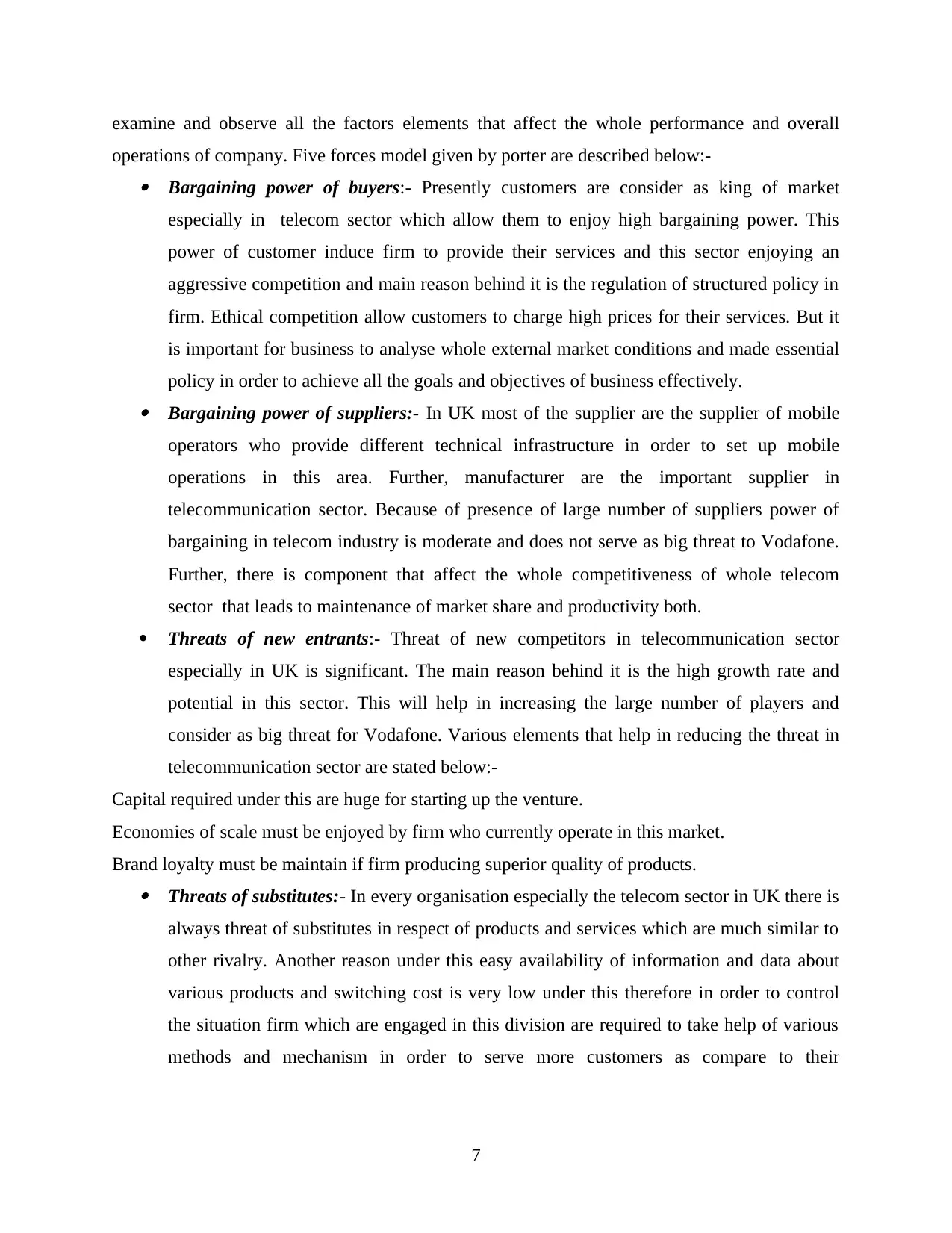
examine and observe all the factors elements that affect the whole performance and overall
operations of company. Five forces model given by porter are described below:- Bargaining power of buyers:- Presently customers are consider as king of market
especially in telecom sector which allow them to enjoy high bargaining power. This
power of customer induce firm to provide their services and this sector enjoying an
aggressive competition and main reason behind it is the regulation of structured policy in
firm. Ethical competition allow customers to charge high prices for their services. But it
is important for business to analyse whole external market conditions and made essential
policy in order to achieve all the goals and objectives of business effectively. Bargaining power of suppliers:- In UK most of the supplier are the supplier of mobile
operators who provide different technical infrastructure in order to set up mobile
operations in this area. Further, manufacturer are the important supplier in
telecommunication sector. Because of presence of large number of suppliers power of
bargaining in telecom industry is moderate and does not serve as big threat to Vodafone.
Further, there is component that affect the whole competitiveness of whole telecom
sector that leads to maintenance of market share and productivity both.
Threats of new entrants:- Threat of new competitors in telecommunication sector
especially in UK is significant. The main reason behind it is the high growth rate and
potential in this sector. This will help in increasing the large number of players and
consider as big threat for Vodafone. Various elements that help in reducing the threat in
telecommunication sector are stated below:-
Capital required under this are huge for starting up the venture.
Economies of scale must be enjoyed by firm who currently operate in this market.
Brand loyalty must be maintain if firm producing superior quality of products. Threats of substitutes:- In every organisation especially the telecom sector in UK there is
always threat of substitutes in respect of products and services which are much similar to
other rivalry. Another reason under this easy availability of information and data about
various products and switching cost is very low under this therefore in order to control
the situation firm which are engaged in this division are required to take help of various
methods and mechanism in order to serve more customers as compare to their
7
operations of company. Five forces model given by porter are described below:- Bargaining power of buyers:- Presently customers are consider as king of market
especially in telecom sector which allow them to enjoy high bargaining power. This
power of customer induce firm to provide their services and this sector enjoying an
aggressive competition and main reason behind it is the regulation of structured policy in
firm. Ethical competition allow customers to charge high prices for their services. But it
is important for business to analyse whole external market conditions and made essential
policy in order to achieve all the goals and objectives of business effectively. Bargaining power of suppliers:- In UK most of the supplier are the supplier of mobile
operators who provide different technical infrastructure in order to set up mobile
operations in this area. Further, manufacturer are the important supplier in
telecommunication sector. Because of presence of large number of suppliers power of
bargaining in telecom industry is moderate and does not serve as big threat to Vodafone.
Further, there is component that affect the whole competitiveness of whole telecom
sector that leads to maintenance of market share and productivity both.
Threats of new entrants:- Threat of new competitors in telecommunication sector
especially in UK is significant. The main reason behind it is the high growth rate and
potential in this sector. This will help in increasing the large number of players and
consider as big threat for Vodafone. Various elements that help in reducing the threat in
telecommunication sector are stated below:-
Capital required under this are huge for starting up the venture.
Economies of scale must be enjoyed by firm who currently operate in this market.
Brand loyalty must be maintain if firm producing superior quality of products. Threats of substitutes:- In every organisation especially the telecom sector in UK there is
always threat of substitutes in respect of products and services which are much similar to
other rivalry. Another reason under this easy availability of information and data about
various products and switching cost is very low under this therefore in order to control
the situation firm which are engaged in this division are required to take help of various
methods and mechanism in order to serve more customers as compare to their
7
⊘ This is a preview!⊘
Do you want full access?
Subscribe today to unlock all pages.

Trusted by 1+ million students worldwide
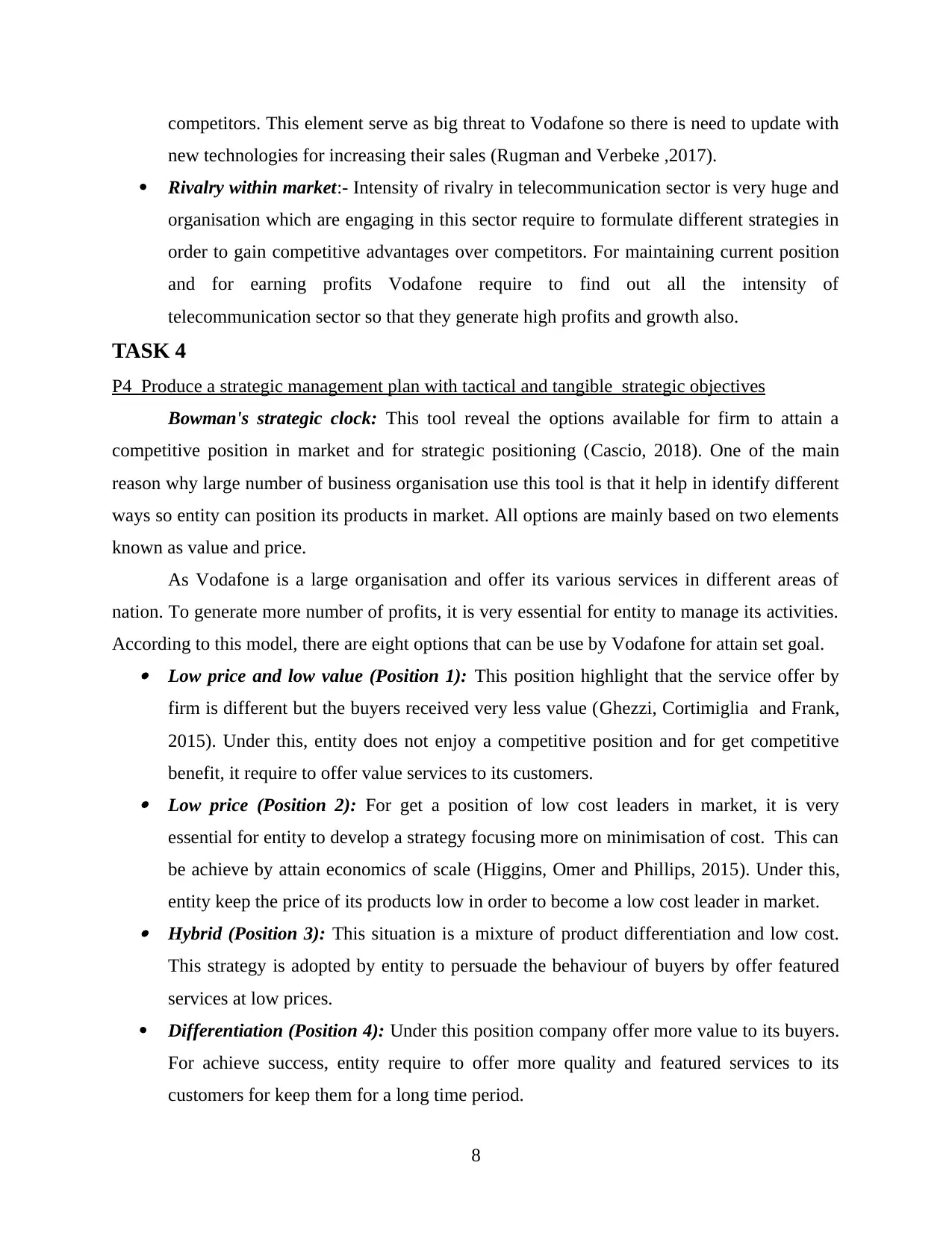
competitors. This element serve as big threat to Vodafone so there is need to update with
new technologies for increasing their sales (Rugman and Verbeke ,2017).
Rivalry within market:- Intensity of rivalry in telecommunication sector is very huge and
organisation which are engaging in this sector require to formulate different strategies in
order to gain competitive advantages over competitors. For maintaining current position
and for earning profits Vodafone require to find out all the intensity of
telecommunication sector so that they generate high profits and growth also.
TASK 4
P4 Produce a strategic management plan with tactical and tangible strategic objectives
Bowman's strategic clock: This tool reveal the options available for firm to attain a
competitive position in market and for strategic positioning (Cascio, 2018). One of the main
reason why large number of business organisation use this tool is that it help in identify different
ways so entity can position its products in market. All options are mainly based on two elements
known as value and price.
As Vodafone is a large organisation and offer its various services in different areas of
nation. To generate more number of profits, it is very essential for entity to manage its activities.
According to this model, there are eight options that can be use by Vodafone for attain set goal. Low price and low value (Position 1): This position highlight that the service offer by
firm is different but the buyers received very less value (Ghezzi, Cortimiglia and Frank,
2015). Under this, entity does not enjoy a competitive position and for get competitive
benefit, it require to offer value services to its customers. Low price (Position 2): For get a position of low cost leaders in market, it is very
essential for entity to develop a strategy focusing more on minimisation of cost. This can
be achieve by attain economics of scale (Higgins, Omer and Phillips, 2015). Under this,
entity keep the price of its products low in order to become a low cost leader in market. Hybrid (Position 3): This situation is a mixture of product differentiation and low cost.
This strategy is adopted by entity to persuade the behaviour of buyers by offer featured
services at low prices.
Differentiation (Position 4): Under this position company offer more value to its buyers.
For achieve success, entity require to offer more quality and featured services to its
customers for keep them for a long time period.
8
new technologies for increasing their sales (Rugman and Verbeke ,2017).
Rivalry within market:- Intensity of rivalry in telecommunication sector is very huge and
organisation which are engaging in this sector require to formulate different strategies in
order to gain competitive advantages over competitors. For maintaining current position
and for earning profits Vodafone require to find out all the intensity of
telecommunication sector so that they generate high profits and growth also.
TASK 4
P4 Produce a strategic management plan with tactical and tangible strategic objectives
Bowman's strategic clock: This tool reveal the options available for firm to attain a
competitive position in market and for strategic positioning (Cascio, 2018). One of the main
reason why large number of business organisation use this tool is that it help in identify different
ways so entity can position its products in market. All options are mainly based on two elements
known as value and price.
As Vodafone is a large organisation and offer its various services in different areas of
nation. To generate more number of profits, it is very essential for entity to manage its activities.
According to this model, there are eight options that can be use by Vodafone for attain set goal. Low price and low value (Position 1): This position highlight that the service offer by
firm is different but the buyers received very less value (Ghezzi, Cortimiglia and Frank,
2015). Under this, entity does not enjoy a competitive position and for get competitive
benefit, it require to offer value services to its customers. Low price (Position 2): For get a position of low cost leaders in market, it is very
essential for entity to develop a strategy focusing more on minimisation of cost. This can
be achieve by attain economics of scale (Higgins, Omer and Phillips, 2015). Under this,
entity keep the price of its products low in order to become a low cost leader in market. Hybrid (Position 3): This situation is a mixture of product differentiation and low cost.
This strategy is adopted by entity to persuade the behaviour of buyers by offer featured
services at low prices.
Differentiation (Position 4): Under this position company offer more value to its buyers.
For achieve success, entity require to offer more quality and featured services to its
customers for keep them for a long time period.
8
Paraphrase This Document
Need a fresh take? Get an instant paraphrase of this document with our AI Paraphraser
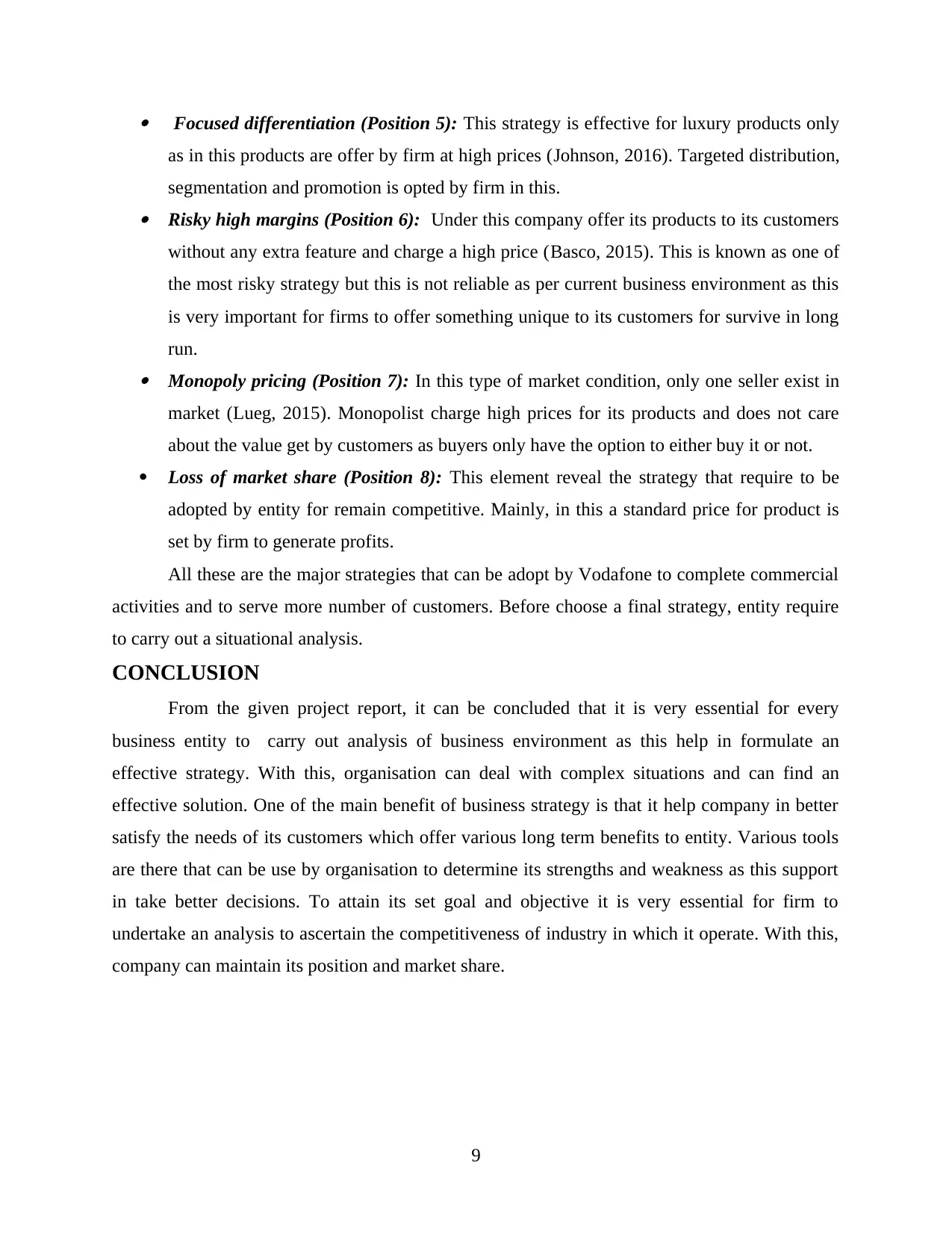
Focused differentiation (Position 5): This strategy is effective for luxury products only
as in this products are offer by firm at high prices (Johnson, 2016). Targeted distribution,
segmentation and promotion is opted by firm in this. Risky high margins (Position 6): Under this company offer its products to its customers
without any extra feature and charge a high price (Basco, 2015). This is known as one of
the most risky strategy but this is not reliable as per current business environment as this
is very important for firms to offer something unique to its customers for survive in long
run. Monopoly pricing (Position 7): In this type of market condition, only one seller exist in
market (Lueg, 2015). Monopolist charge high prices for its products and does not care
about the value get by customers as buyers only have the option to either buy it or not.
Loss of market share (Position 8): This element reveal the strategy that require to be
adopted by entity for remain competitive. Mainly, in this a standard price for product is
set by firm to generate profits.
All these are the major strategies that can be adopt by Vodafone to complete commercial
activities and to serve more number of customers. Before choose a final strategy, entity require
to carry out a situational analysis.
CONCLUSION
From the given project report, it can be concluded that it is very essential for every
business entity to carry out analysis of business environment as this help in formulate an
effective strategy. With this, organisation can deal with complex situations and can find an
effective solution. One of the main benefit of business strategy is that it help company in better
satisfy the needs of its customers which offer various long term benefits to entity. Various tools
are there that can be use by organisation to determine its strengths and weakness as this support
in take better decisions. To attain its set goal and objective it is very essential for firm to
undertake an analysis to ascertain the competitiveness of industry in which it operate. With this,
company can maintain its position and market share.
9
as in this products are offer by firm at high prices (Johnson, 2016). Targeted distribution,
segmentation and promotion is opted by firm in this. Risky high margins (Position 6): Under this company offer its products to its customers
without any extra feature and charge a high price (Basco, 2015). This is known as one of
the most risky strategy but this is not reliable as per current business environment as this
is very important for firms to offer something unique to its customers for survive in long
run. Monopoly pricing (Position 7): In this type of market condition, only one seller exist in
market (Lueg, 2015). Monopolist charge high prices for its products and does not care
about the value get by customers as buyers only have the option to either buy it or not.
Loss of market share (Position 8): This element reveal the strategy that require to be
adopted by entity for remain competitive. Mainly, in this a standard price for product is
set by firm to generate profits.
All these are the major strategies that can be adopt by Vodafone to complete commercial
activities and to serve more number of customers. Before choose a final strategy, entity require
to carry out a situational analysis.
CONCLUSION
From the given project report, it can be concluded that it is very essential for every
business entity to carry out analysis of business environment as this help in formulate an
effective strategy. With this, organisation can deal with complex situations and can find an
effective solution. One of the main benefit of business strategy is that it help company in better
satisfy the needs of its customers which offer various long term benefits to entity. Various tools
are there that can be use by organisation to determine its strengths and weakness as this support
in take better decisions. To attain its set goal and objective it is very essential for firm to
undertake an analysis to ascertain the competitiveness of industry in which it operate. With this,
company can maintain its position and market share.
9
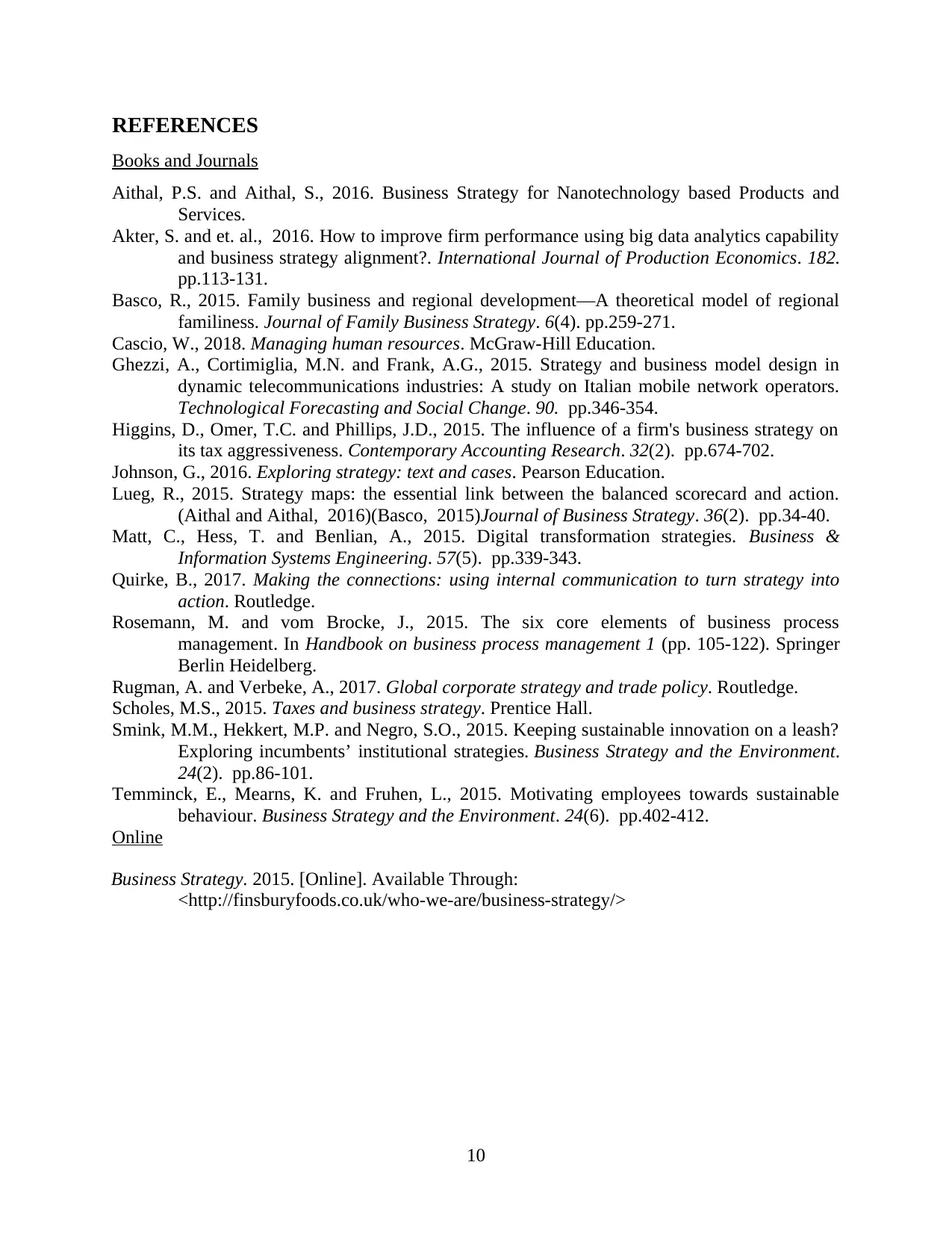
REFERENCES
Books and Journals
Aithal, P.S. and Aithal, S., 2016. Business Strategy for Nanotechnology based Products and
Services.
Akter, S. and et. al., 2016. How to improve firm performance using big data analytics capability
and business strategy alignment?. International Journal of Production Economics. 182.
pp.113-131.
Basco, R., 2015. Family business and regional development—A theoretical model of regional
familiness. Journal of Family Business Strategy. 6(4). pp.259-271.
Cascio, W., 2018. Managing human resources. McGraw-Hill Education.
Ghezzi, A., Cortimiglia, M.N. and Frank, A.G., 2015. Strategy and business model design in
dynamic telecommunications industries: A study on Italian mobile network operators.
Technological Forecasting and Social Change. 90. pp.346-354.
Higgins, D., Omer, T.C. and Phillips, J.D., 2015. The influence of a firm's business strategy on
its tax aggressiveness. Contemporary Accounting Research. 32(2). pp.674-702.
Johnson, G., 2016. Exploring strategy: text and cases. Pearson Education.
Lueg, R., 2015. Strategy maps: the essential link between the balanced scorecard and action.
(Aithal and Aithal, 2016)(Basco, 2015)Journal of Business Strategy. 36(2). pp.34-40.
Matt, C., Hess, T. and Benlian, A., 2015. Digital transformation strategies. Business &
Information Systems Engineering. 57(5). pp.339-343.
Quirke, B., 2017. Making the connections: using internal communication to turn strategy into
action. Routledge.
Rosemann, M. and vom Brocke, J., 2015. The six core elements of business process
management. In Handbook on business process management 1 (pp. 105-122). Springer
Berlin Heidelberg.
Rugman, A. and Verbeke, A., 2017. Global corporate strategy and trade policy. Routledge.
Scholes, M.S., 2015. Taxes and business strategy. Prentice Hall.
Smink, M.M., Hekkert, M.P. and Negro, S.O., 2015. Keeping sustainable innovation on a leash?
Exploring incumbents’ institutional strategies. Business Strategy and the Environment.
24(2). pp.86-101.
Temminck, E., Mearns, K. and Fruhen, L., 2015. Motivating employees towards sustainable
behaviour. Business Strategy and the Environment. 24(6). pp.402-412.
Online
Business Strategy. 2015. [Online]. Available Through:
<http://finsburyfoods.co.uk/who-we-are/business-strategy/>
10
Books and Journals
Aithal, P.S. and Aithal, S., 2016. Business Strategy for Nanotechnology based Products and
Services.
Akter, S. and et. al., 2016. How to improve firm performance using big data analytics capability
and business strategy alignment?. International Journal of Production Economics. 182.
pp.113-131.
Basco, R., 2015. Family business and regional development—A theoretical model of regional
familiness. Journal of Family Business Strategy. 6(4). pp.259-271.
Cascio, W., 2018. Managing human resources. McGraw-Hill Education.
Ghezzi, A., Cortimiglia, M.N. and Frank, A.G., 2015. Strategy and business model design in
dynamic telecommunications industries: A study on Italian mobile network operators.
Technological Forecasting and Social Change. 90. pp.346-354.
Higgins, D., Omer, T.C. and Phillips, J.D., 2015. The influence of a firm's business strategy on
its tax aggressiveness. Contemporary Accounting Research. 32(2). pp.674-702.
Johnson, G., 2016. Exploring strategy: text and cases. Pearson Education.
Lueg, R., 2015. Strategy maps: the essential link between the balanced scorecard and action.
(Aithal and Aithal, 2016)(Basco, 2015)Journal of Business Strategy. 36(2). pp.34-40.
Matt, C., Hess, T. and Benlian, A., 2015. Digital transformation strategies. Business &
Information Systems Engineering. 57(5). pp.339-343.
Quirke, B., 2017. Making the connections: using internal communication to turn strategy into
action. Routledge.
Rosemann, M. and vom Brocke, J., 2015. The six core elements of business process
management. In Handbook on business process management 1 (pp. 105-122). Springer
Berlin Heidelberg.
Rugman, A. and Verbeke, A., 2017. Global corporate strategy and trade policy. Routledge.
Scholes, M.S., 2015. Taxes and business strategy. Prentice Hall.
Smink, M.M., Hekkert, M.P. and Negro, S.O., 2015. Keeping sustainable innovation on a leash?
Exploring incumbents’ institutional strategies. Business Strategy and the Environment.
24(2). pp.86-101.
Temminck, E., Mearns, K. and Fruhen, L., 2015. Motivating employees towards sustainable
behaviour. Business Strategy and the Environment. 24(6). pp.402-412.
Online
Business Strategy. 2015. [Online]. Available Through:
<http://finsburyfoods.co.uk/who-we-are/business-strategy/>
10
⊘ This is a preview!⊘
Do you want full access?
Subscribe today to unlock all pages.

Trusted by 1+ million students worldwide
1 out of 13
Related Documents
Your All-in-One AI-Powered Toolkit for Academic Success.
+13062052269
info@desklib.com
Available 24*7 on WhatsApp / Email
![[object Object]](/_next/static/media/star-bottom.7253800d.svg)
Unlock your academic potential
Copyright © 2020–2025 A2Z Services. All Rights Reserved. Developed and managed by ZUCOL.





